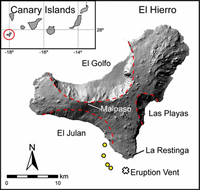Xenopumice erupted on 15 October 2011 offshore of El Hierro (Canary Islands): a subvolcanic snapshot of magmatic, hydrothermal and pyrometamorphic processes
Del Moro S., A. Di Roberto, S. Meletlidis, M. Pompilio, A. Bertagnini, S. Agostini, F. Ridolfi, A. Renzulli.
Bulletin of Volcanology, Volume 77, Issue 6, doi:10.1007/s00445-015-0940-0.
Abstract
On 15 October 2011, a submarine eruption offshore of El Hierro Island gave rise to floating volcanic products, known as xenopumices, i.e., pumiceous xenoliths partly mingled and coated with the juvenile basanitic magma. Over the last few years, no consensus in the scientific community in explaining the origin of these products has been reached. In order to better understand the formation of xenopumice, we present a textural, mineralogical, and geochemical study of the possible magmatic, hydrothermal, and pyrometamorphic processes, which usually operate in the plumbing systems of active volcanoes. We carried out a comprehensive SEM investigation and Sr-Nd-Pb isotope analyses on some samples representative of three different xenopumice facies. All the data were compared with previous studies, new data for El Hierro extrusives and a literature dataset of Canary Islands igneous and sedimentary rocks. In the investigated xenopumices, we emphasize the presence of restitic magmatic phases as well as crystallization of minerals (mainly olivine + pyroxene + magnetite aggregates) as pseudomorphs after pre-existing mafic phenocrysts, providing evidence of pyrometamorphism induced by the high-T juvenile basanitic magma. In addition, we identify veins consisting of zircon + REE-oxides + mullite associated with Si-rich glass and hydrothermal quartz, which indicate the fundamental role played by hydrothermal fluid circulation in the xenopumice protolith. The petrological data agree with a pre-syneruptive formation of the xenopumice, when El Hierro basanite magma intruded hydrothermally altered trachyandesite to trachyte rocks and triggered local partial melting. Therefore, the El Hierro xenopumice represents a snapshot of the transient processes at the magma-wall rock interface, which normally occurs in the feeding system of active volcanoes.


